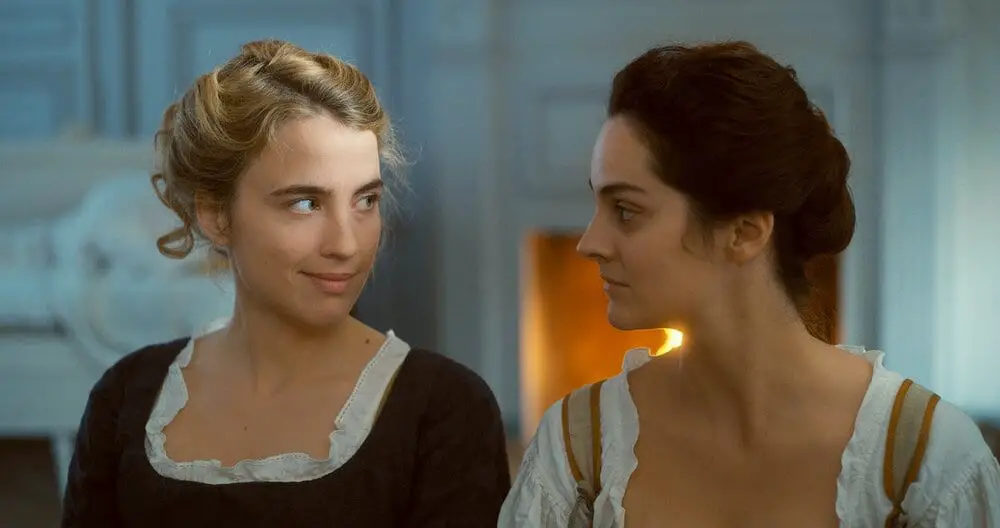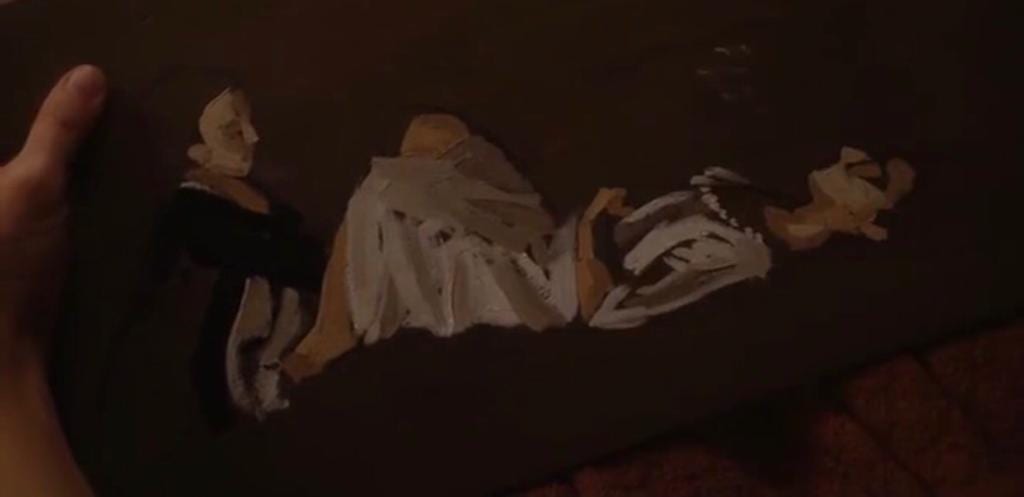Since winning the Cannes Film Festival Award for Best Screenplay, (and since Adele Hanel’s iconic walkout from the Ceasar Awards in protest of Roman Polanski’s win), Celine Sciamma’s Portrait of a Lady on Fire has been garnering international attention, winning over critics and audiences with its unforgettable story.
Personally, I believe the film is a masterpiece. With her signature minimalism, Sciamma brings to life an art piece composed of smaller art pieces; every frame of the movie could be immortalized as classical art, every word of dialogue has a meaning.
The movie is told through a framed narrative, as Marianne (Noemi Merlant), an 18thcentury artist thinks back to her romantic affair with a young aristocratic woman, Heloise (Adele Haenel) who is to be married to a Milanese nobleman. Marianne is commissioned to paint a portrait of Heloise for her future husband, yet is informed that Héloïse has previously refused to pose as she does not want to be married. Marianne acts as Heloise’s hired companion to be able to paint her in secret and accompanies her on daily walks to memorize Heloise’s features. Through their walks, Marianne slowly gains Heloise’s trust, friendship eventually giving way to love.
I won’t dwell much on the plot here, (but if you do want to read more about the plot there is a wonderful article by Jan Kalina). Instead, I would like to explore how Sciamma’s artistic choices tell a story of their own, elevating the critically acclaimed motion picture to a painting that tells an almost hidden story.
Movies frequently play on our role as voyeurs, as watchers, to share complicity with the characters. Sciamma instead elevates our own act of watching into something artful, inviting us to not only witness a love story but to study and judge her own masterpiece. She invites us to see the movie as a meditation on time and art, mortality (in all its senses), and creativity. Sciamma is showing us a love story between two young women as well as a careful meditation of the relationship between a painter and her muse, between two colors in a canvass, and the lasting power of perspective.
It’s certainly no mistake that at the very beginning of the movie, the first words uttered by Marianne to her students—or Sciamma’s first words to us—is “regarde”: look at me. Study me. See me.
Since the beginning, the movie encourages us to unashamedly gaze at every detail of the sparsely beautiful 18th-century interiors, spectacular coastal landscape, and the three central women, almost as if we’re looking at a love interest or a painting. The details are beautifully placed; the hint of Heloise’s leg as she runs, the blue of her eyes, the placement of her hands. By aligning it with Marianne’s, Sciamma imbues our gaze with significance. Heloise is our muse, a mysterious aristocrat to be admired, an object for us to take pleasure in watching.
Yet, with her rejection of the first paintings, Heloise invites Marianne (and us) to look closer. Heloise, who always wears black and likes to run. The Heloise who obstinately refused to sit for a painting, and did not allow greater society to look at her.
It’s worth noting that Helene Domair, the artist commissioned to do all of the paintings shown in the movie has a distinct signature in all of her works; her portraits of young women all have their eyes blotted out. If the eyes are truly the windows of the soul, then we cannot see them, and thus cannot own them. As 18th-century philosophers ask: to what extent does the power of the gaze hold?
Her rejection of the first painting is tied to her refusal to be objectified. The first painting is the embodiment of how she’s viewed and desired by aristocratic society. In her eyes, and eventually in Mariannes, the painting falls flat, it is two dimensional and devoid of life. In it, Heloise is passive, no more than an object. With her rejection, we see that our gaze held the power to oppress her.
When confronted by Heloise: “Is this how you see me?” Marianne is defensive, “there are rules, things that must be honored” To paraphrase, Sorry, Heloise, I can’t look at you the way you’re asking me too. My artistic expression is too closely judged and rendered by a patriarchal society that doesn’t allow me to. Yet when Marianne is again confronted by the passive expression of her own painting, Marianne understands, and blots out the eyes.
And so Marianne is determined to paint a second painting, one which can transcend the artistic and societal bounds set on them both. As she now looks to Heloise as an equal, she allows Heloise to gaze back, and retake her power. Thus their relationship flourishes like flowers in the mantlepiece. As actress Adele Haenel commented on the transformation throughout the movie: “I wanted (Heloise) to travel from being an object to being a subject”

As the relationship between Marianne and Heloise grows, their contrasting natures become more pronounced. Marianne, who Sciamma chooses to associate with the color red, is the personification of water. First introduced in the ocean, Marianne is cool and collected, both passive and strong. Of course, as it is Marianne’s version of the story, every important event in through the movie happens on a beach.
Heloise, who initially wears black—refusing to wear the color associated with wealth, youth and fertility—is instead personified by fire. It is representative of the anger she carries but cannot express, as well as her rage in her forced domesticity, as she is often in an empty room but nothing but a fire behind her.
It is when their essences come together, as Marianne plays Antonio Vivaldi’s Storm on the pianoforte, (water+fire= storm) that Heloise first looks to Marianne with desire and understanding.

The duality of the couple—red and black, fire and water, life and death—culminates in the feast, in which Heloise’s dress catching on fire not only signifies Marianne’s consuming desire for her but Heloise’s phoenix-like transformation from a confining domestic space to one of her own, even at the expense of death.
The impacting duality between life and death (or self-will and submission, as it is often the case with women in patriarchal societies) is also represented in another, often overlooked, aspect of the film: the abortion.
Sciamma has stated that she felt necessary to include a young woman getting an abortion in the film, as she wanted to celebrate the relationships and experiences of women which are not often told. And yet, as Marianne paints Heloise recreating the abortion with the maid Sophia (played by Luàna Bajrami), it almost seems as it is a picture of birth. Are the subjects in the painting giving life, or taking it away? Sciamma’s genius is that it is both.

While we know Sophie is indeed having an abortion, the painting celebrates the transferring of life between two women. Through this ‘death’, Heloise gives Sophie life. (Bearing in mind that in the 18thcentury, pregnancy for single working women either resulted in her death or her immediate dismissal)
The theme of through death comes life is also significant in the big undercurrent of the film; Orpheus and Eurydice. This myth also serves to link another two great frames of the film: the present of love and the memory of love. Marianne puts forward a hypothesis that resembles her: To make the poet’s choice and choose a memory of love over the present. Heloise, however, chooses the lover’s choice, to accept death in order to give your lover life: “Perhaps she was the one who said: ‘turn around'”
Of course, this is what Heloise does as Marianne leaves the chateau, and her life, forever. “Turn around” Look at me. See me. The gaze which was once unwelcomed is now desired because the look of a lover, or of an artist, that gaze which can give death can also give life, and vice-versa. Heloise, now empowered is saying “Remember me. Remember this.”

It all comes together as in the film’s final scene we look at Heloise again through Marianne’s eyes. We see her crying yet elated, enveloped by Vivaldi’s Storm and the connection that they had once shared. Sciamma’s final message to us comes through Marianne, as she narrates that Heloise, sitting opposite of her in the theater “didn’t see me”. And yet, as we gaze upon Heloise transfixed by the artistic piece that connected them, we know that she did.





Wow! So beautifully and deeply written, like the movie is in itself. This movie has so many layers that it will take forever to analyse every single intricate detail. A masterpiece it is.
Glad you enjoyed it! 🙂
Thank you for this beautiful article on this burning masterpiece! 🔥